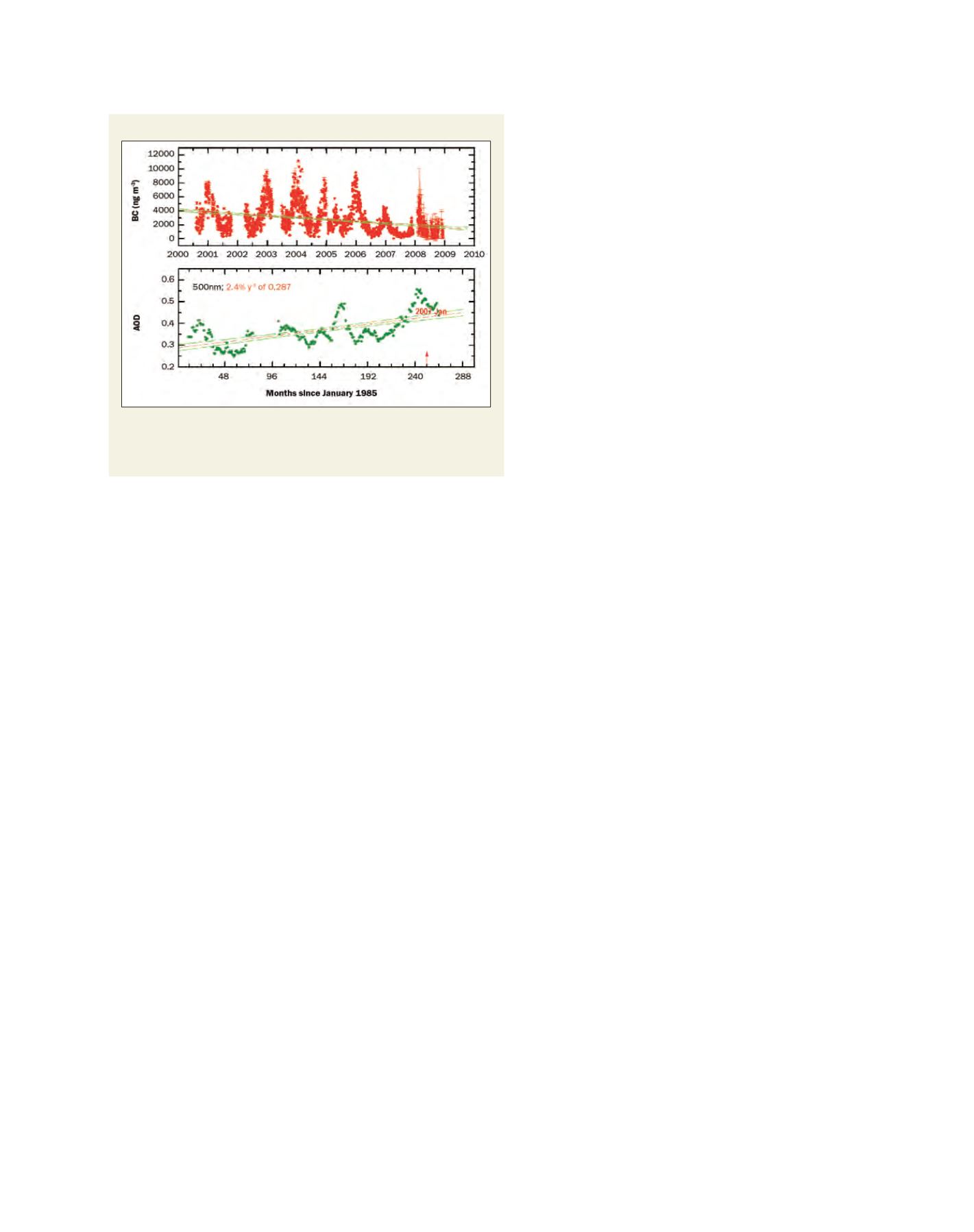

[
] 158
O
bserving
, P
redicting
and
P
rOjecting
c
limate
c
OnditiOns
Strong signatures of marine aerosols are even
reported in the interiors during summer.
11
Over
central and northern India, dust, produced locally or
transported from the arid regions of Africa, Arabia and
Asia, contributes significantly to aerosol abundance and
AOD throughout the spring and summer. A synergy
of ground-based and satellite infrared measurements
shows that the absorption efficiency of dust is higher
over Asia than Africa
12
during winter – when the dust
is aged and mixed with soot – while the more nascent
summer dust has lower absorption efficiency. Chemical
reactions involving this dust result in neutralization of
acidic and maintain alkaline rainwater.
13
Urbanization has resulted in the evolution of urban
conglomerations in India. An analysis over four
regional mega cities – Chennai, Mumbai, Kolkata and
New Delhi – showed high AOD with strong seasonal
variations. Of these, Chennai had the least AOD, while
Kolkatta (eastern coast) had the most fine mode aero-
sols throughout the year. In the other two cities, the fine
mode contribution varied as a function of season; being
very high in winter. During pre-monsoon and summer,
coarse mode aerosols associated with dust and sea salt
dominated the distribution.
14
Thus, even the mega
cities show temporal heterogeneity, making it difficult
to model for regional ARF estimation.
Modulation by atmospheric dynamics
Aerosol abundance, composition and vertical distribution
over India is strongly modulated by the natural dynamical
features of the atmosphere. Based on multi-year, multi-
station data on AOD, it has been shown
15
that AOD over
the peninsula tends to be higher in the years when the
southward excursion of the intertropical convergence
zone is smaller. Long-range transport of aerosols leads to
significant modulations in aerosol properties, and corre-
sponding changes in ARF and in forcing efficiency, which
implies changes in the aerosol types and impacts. While
the advection of mineral dust-richWest Asian and Arabian
desert aerosols are important over the Arabian Sea and
western parts of the peninsula during March to May,
16
advection of fine and accumulation mode aerosols from
the East Asian regions cause large perturbations in spectral
AOD and BC concentrations over the Bay of Bengal during
January to April.
17
Over the Ganga basin, the dynamics of
the shallow atmospheric boundary layer (ABL) strongly
influences the build-up and spatial confinement of aero-
sols and trace gases from local emissions.
18
While the
deepening ABL in spring and summer flushes the pollut-
ants further aloft resulting in a dilution in their surface
concentration,
19
stronger long-range transport leads to
increase in AOD and ARF over the entire north-Indian
Plains.
20
This leads to large space-time heterogeneity in
AOD and its spectral variation over India.
21
The tropical atmosphere supports a variety of plan-
etary scale wave motions, the propagation of which
causes significant modulations to the abundance and
type of aerosols resulting in corresponding modula-
tions in ARF. The eastward propagating Madden Julian
balloon borne measurements of the altitude distribution of aerosols
and trace gases.
7
As a result, ISRO, while formulating its Geosphere
Biosphere Programme (I_GBP), identified Aerosol Climatology and
Effects (ACE) and characterization of trace gases as central activities.
ACE activity proliferated under I_GBP to become a national effort.
A network of ground-based observatories were established for regional
aerosol characterization. As the programme matured, it became the
Aerosol Radiative Forcing over India project (ARFI), which is now a
network spanning the entire country and surrounding oceans. Some of
its stations have databases of more than two decades for AOD and several
years for black carbon (BC), enabling quantifying of long-term trends.
Data from Trivandrum, a remote coastal location in the southern
peninsula, shows the monthly AOD at 500nm. While the increase in
AOD of ~2.4 per cent per year from its base value in 1985 is of concern,
it is equally interesting that the concentration of BC, normally consid-
ered as a tracer for human impact, shows a decreasing trend of ~250
ng m-3 y-1. This has several implications. The reduction of surface BC
could be considered an indicator of emission control strategies, while
the increase in AOD indicates an overall increase in columnar abun-
dance. It remains to be seen whether this increase is occurring at higher
levels, above the atmospheric boundary layer.
Natural and anthropogenic
Despite the need to focus on anthropogenic aerosols from the climate
changemitigation perspective, the role of natural aerosols in ARF should
not be underestimated over the Indian region. Campaign mode obser-
vations over the oceans
8
and long-termmeasurements from islands and
the mainland have shown dramatic change in aerosol characteristics
(abundance, vertical distribution, composition, and size distribution)
due to large influx of marine aerosols, leading to large reduction in
AOD, and flattening of its spectral response. This caused a significant
reduction (by more than a factor of >2) in the ‘top of the atmosphere’
and atmospheric ARF.
9
Chemical speciation analysis shows an increase
in the concentration of water-soluble salts from 29 per cent in winter
to 44 per cent in summer.
10
Trends in aerosol optical depth and black carbon mass
Source: ARFI, I-GBP
Trends of AOD at 500nm (bottom) and black carbon mass concentration (top)
over Trivandrum. The points are monthly means for AOD and daily means for
black carbon. Mean trend lines and 95 per cent confidence bands are also shown
















